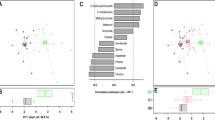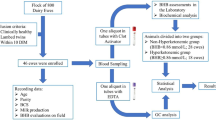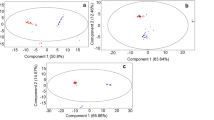Abstract
THE virtual dependence of ruminants on endogenous sources of glucose and the relative abundance of short-chain fatty acids have stimulated much discussion on the possible existence in ruminant tissues of pathways leading to the net conversion of fatty acids to glucose. Butyrate, in particular, has been the subject of controversy since Potter1 found that sodium butyrate injected intravenously relieved insulin convulsions. Several investigators have observed raised blood sugar concentrations following butyrate administration2–6, and Shaw7 has reported the net conversion of large amounts of butyrate to carbohydrate by the perfused goat liver. Kleiber et al.8 obtained appreciable labelling of milk lactose following the intravenous administration of labelled butyrate in cows, but more recently, the absence of pathways which would account for the ‘glucogenic’ behaviour of butyrate in the lactating cow has been convincingly demonstrated9. Lauryssens, Verbeke, Peeters and Reinards10 compared the incorporation into cow's milk constituents of butyrate labelled in the C-1 or C-3 positions and concluded that butyrato metabolism proceeded after cleavage into two-carbon fragments, a well-established pathway in other tissues.
This is a preview of subscription content, access via your institution
Access options
Subscribe to this journal
Receive 51 print issues and online access
$199.00 per year
only $3.90 per issue
Buy this article
- Purchase on Springer Link
- Instant access to full article PDF
Prices may be subject to local taxes which are calculated during checkout
Similar content being viewed by others
References
Potter, B. J., Nature, 170, 541 (1952).
Jarrett, I. G., Potter, B. J., and Filsell, O. H., Austral. J. Exp. Biol. Med. Sci., 30, 197 (1952).
Johnson, R. B., Cornell Vet., 45, 273 (1955).
Clark, R., and Malan, J. R., Onderstepoort J. Vet. Res., 27, 101 (1956).
Kronfeld, D. S., Nature, 178, 1290 (1956).
Kronfeld, D. S., Campbell, L. A., Hooper, I. L., and Galligan, S. J., Amer. J. Vet. Res., 20, 430 (1959).
Shaw, J. C., Oklahoma Conf. Radioisotopes in Agriculture, U.S. Atomic Energy Comm. (1959).
Kleiber, M., Black, A. L., Brown, M. A., Luick, J., Baxter, C. F., and Tolbert, B. M., J. Biol. Chem., 210, 239 (1954).
Black, A. L., Kleiber, M., and Brown, A. M., J. Biol. Chem., 236, 2399 (1961).
Lauryssens, M., Verbeke, R., Peeters, G., and Reinards, M. T., J. Dairy Res., 27, 151 (1960).
Bernstein, I. A., and Wood, H. G., Methods in Enzymology, 4 (Academic Press, Inc., New York, 1957).
Weinman, E. O., Strisower, E. H., and Chaikoff, I. L., Physiol. Rev., 37, 252 (1957).
Umbreit, W. W., Burris, R. H., and Stauffer, J. F., Manometric Techniques and Tissue Metabolism (Burgess Pub. Co., Minneapolis, 1957).
Author information
Authors and Affiliations
Rights and permissions
About this article
Cite this article
LENG, R., ANNISON, E. Possible Glucogenicity of Butyrate in Sheep. Nature 196, 674–675 (1962). https://doi.org/10.1038/196674a0
Issue Date:
DOI: https://doi.org/10.1038/196674a0
Comments
By submitting a comment you agree to abide by our Terms and Community Guidelines. If you find something abusive or that does not comply with our terms or guidelines please flag it as inappropriate.



